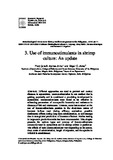Use of immunostimulants in shrimp culture: An update
Share
trừu tượng
Different approaches are used to prevent and control diseases in aquaculture. Immunostimulation is one method that is gaining popularity and is considered a promising development in aquaculture. Immunostimulants were found to be effective in enhancing parameters of non-specific immunity and resistance to diseases of fish and crustaceans. However, some issues raised on the use of immunostimulants pertains to the short-term nature of immune indices used during efficacy evaluation, possible detrimental effects during long-term administration, or self-damage due to unregulated production of immune effectors. Further testing in large-scale production units has been recommended. This chapter presents the various types and sources of immunostimulants commonly used in aquaculture and in shrimp culture in particular. The effects of each immunostimulant vary depending on its source, dose, route of administration, length of exposure, and the species to which it is administered.
Suggested Citation
Apines-Amar, M. J. S., & Amar, E. C. (2015). Use of immunostimulants in shrimp culture: An update. In C. M. A. Caipang, M. B. I. Bacano-Maningas, & F. F. Fagutao (Eds.), Biotechnological Advances in Shrimp Health Management in the Philippines (pp. 45-71). Kerala, India: Research Signpost.


